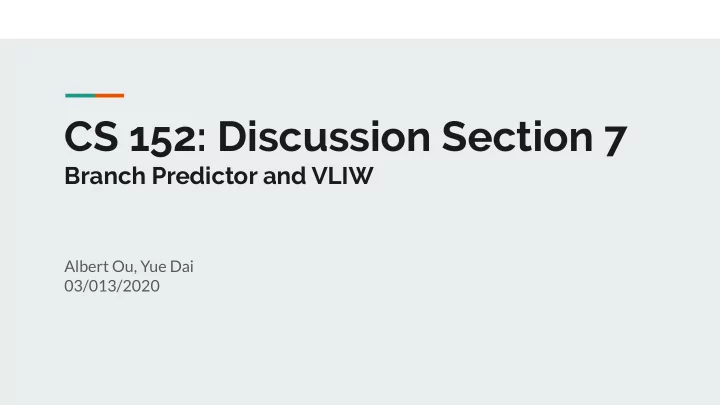

CS 152: Discussion Section 7 Branch Predictor and VLIW Albert Ou, Yue Dai 03/013/2020
Administrivia Problem Set 3 due 10:30am on Mon, March 16 ● Lab 3 released today, due 10:30am on Mon, April 6 ● Midterm 1 scores are available on Gradescope ● One week to submit regrade requests ○ Regrade window opens at 4pm today ○ Solutions posted on course webpage ○
Agenda Branch Prediction ● Branch History Table ○ Branch Target Buffer ○ Load/Store Queue ● VLIW ● Software Pipelining ○ Lab 3 overview ●
Branch Prediction - BHT ● Exploit temporal correlation ● How to learn based on spatial correlation?
Branch Prediction - BHT ● Use history register ● Worksheet Q1 ● Q: what’s the limitation of just using BHT?
Branch Prediction - BTB Index by branch PC but need checking ● whether PC matches, and contains branch PC and target PC in the same line. Q: What target PC should be stored? ● Should we store the not-taken target PC? Q: Which happens earlier? BTB check or ● BHT check? Q: When should BTB be updated? ●
Branch Prediction - BTB update Here we assume using both ● BTB and BHT. BTB check in IF stage, BHT check in decode stage But in a real design, the fetch ● stage may be pipelined, which makes BHT check occur in a later stage of IF. Computer Architecture, A Quantitative Approach Ch3.9
Load/Store Queue We would like to speculatively issue loads without violating in-order semantics and precise ● exceptions Q: What extra structure do you need? ●
Load/Store Queue Speculative Store Buffer ● Dispatch: ○ Store: allocate an entry in store buffer in program order ■ Load: record the position of youngest store instruction ■ older than this load Execute: ○ Store: update the corresponding address and data in ■ store buffer Load: can only execute when all older store address are ■ known; Find all stores prior to the load; If has, forward the data from the youngest match to load / If not, load from cache Commit: ○ Store: store the data to cache, free that entry ■ Load: commit normally ■ Q: What if you want to be more aggressive? ● Speculative load
Load/Store Queue Speculative Store Buffer + Load Queue ● SQ ○ Can execute load instruction without waiting for all previous store address are known ○ Load Queue is used to keep the order of load instructions. ○ When a store address is finished execution, check all load addresses in load queue which is younger than this store. ■ If no match, keep executing normally ■ If has match, flush all instruction executions after the oldest load match Problem: too expensive, large penalty for ● inaccurate addressspeculation
VLIW Compiler ● VLIW compiler needs to explicitly schedule operations to maximize parallel execution and avoid ○ data hazards Guarantees intra-instruction parallelism ○ Q: How to better schedule the code ● Loop unrolling ○ Software pipelining ○ Trace scheduling ○
VLIW - Software pipelining Software pipelining pays ● startup/wind-down costs only once per loop, not once per iteration Worksheet Q2 ●
VLIW - Trace scheduling Find the most frequent branch path and optimize it ● Use profiling feedback ● Add fix up code ●
VLIW - Predicated execution Remove mispredicted branches by using predicated execution with predict register ● Predicate register true: execute; false: nop ● Predicate register Execute either inst 3 & inst 4 or inst 5 & inst 6
BOOM: Berkeley Out-of-Order Machine Open-source, synthesizable, out-of-order superscalar RISC-V core ● Heavily inspired by the MIPS R10000 and Alpha 21264 ● Unified physical register file with explicit renaming ● Split ROB / issue window design ● Extensively parameterized: ● Fetch and issue widths, ROB size, LSU size ○ Functional unit mix, latencies ○ Issue scheduler ○ Composable branch predictors, RAS size, BTB size ○ Commit map table (R10k rollback vs Alpha 21264 single-cycle flush) ○ Maximum in-flight branches ○
BOOM: Berkeley Out-of-Order Machine
Open-Ended: Branch predictor design Implement a branch predictor in C++ that integrates with BOOM ● Objective is to improve accuracy over baseline BHT ● Competition: ● Winning team receives 10% extra credit ○ Limited division : Constrained to 64 KiB of storage, plus 2048 bits of additional budget ○ Open division : No restrictions ○ Gradescope autograder will be deployed next week ○
Open-Ended: Spectre attacks Spectre/Meltdown : Microarchitectural side-channel attacks that exploit branch prediction, ● speculative execution, and cache timing to bypass security mechanisms Objective is to recreate Spectre attacks on BOOM ● Attack scenario ● Vulnerable Spectre gadget present in supervisor syscall code ○ Write user program to infer secret data from protected kernel memory using branch predictor mis-training ○ and cache side effects Team that can guess most bytes correctly receives 10% extra credit ● Gradescope autograder will be deployed next week ○
Recommend
More recommend